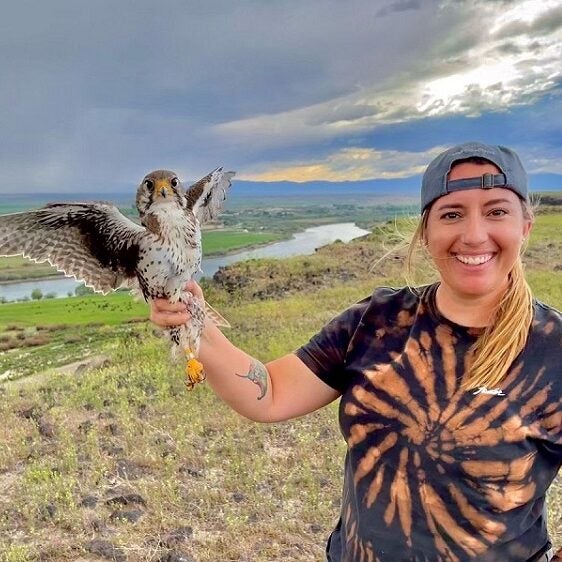
Boise State University MS Raptor Biology student Eden Ravecca defended her thesis, “Impacts of Habitat Type on Individual of Prairie Falcon (Falco mexicanus) Movement and Foraging Behavior During the Breeding Season” at midday on June 2, 2023. Ravecca’s main advisor is Dr. Jen Cruz (Biological Sciences, Raptor Research Center), and her committee included Dr. Todd Katzner (USGS) and Dr. Trevor Caughlin (Biological Sciences).
Abstract
Animal movement is a fundamental characteristic of the ecology, fitness, and evolution of species. How and why animals move across habitats is central to conservation, however, relying solely on population-level estimates obscures individual differences and can result in ineffective management strategies. Understanding the mechanistic underpinnings of movement and individual variation among wide-ranging aerial predators is particularly challenging but imperative, given the critical role of higher trophic levels in ecosystem functioning. I shed new light on the movement ecology of 17 breeding Prairie Falcons within the Morley Nelson Snake River Birds of Prey National Conservation Area in southwest Idaho. I used GPS-GSM telemetry units to track individual movement during the breeding seasons of 2021 and 2022. I aimed to evaluate functional use, individual differences, and temporal shifts in how Prairie Falcons move through a mosaic landscape.
Using hidden Markov models for each individual, I classified their movements into two states: (1) ‘canted’, relatively tortuous movement that captures foraging-related behaviors such as prospecting, high-angle stoops, or high-maneuver chasing; and (2) ‘strafing’, relatively directional movement that captures high-speed powered flight such as commuting to foraging areas or direct-pursuit hunting. I related several model parameters to four structurally different habitat types (sagebrush, non-sagebrush shrub, annual herbaceous, and perennial herbaceous). Results revealed that individual Prairie Falcons varied widely in their functional use of habitat. Some individuals relied on canted movement as native perennial or invasive annual cover increased in open herbaceous habitats. For some Prairie Falcons, switching to strafing movement appeared to be the preferred strategy as native sagebrush cover increased in shrub-dominated habitats. During the brood-rearing period, Prairie Falcons exhibited an increase in the relative proportion of time in a strafing movement state (i.e. fast, directional movement), suggesting that they increase how much or how far they travel when food demand is the highest.
Versatility among individual Prairie Falcons was evident across native and non-native habitat types and hints at their potential resilience to the ongoing degradation of dryland ecosystems. Knowledge of functional habitat use can contribute to the development of effective conservation strategies, while knowledge of individual differences provides insights into the adaptive capacity of Prairie Falcon populations in a rapidly changing world.